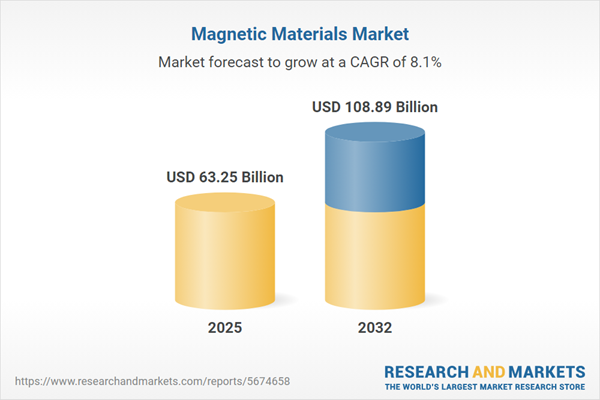Speak directly to the analyst to clarify any post sales queries you may have.
The magnetic materials market stands at the forefront of critical technology transformation, supporting sectors from mobility to advanced electronics and energy systems. As industries rapidly evolve, market leaders are redefining strategies to ensure resilience, efficiency, and growth in a landscape shaped by shifting innovation, supply chain dynamics, and policy changes.
Market Snapshot: Magnetic Materials Market Growth and Outlook
The Magnetic Materials Market grew from USD 58.46 billion in 2024 to USD 63.25 billion in 2025. It is expected to continue growing at a CAGR of 8.08%, reaching USD 108.89 billion by 2032. These figures underscore robust, sustained demand across automotive, electronics, energy, and healthcare industries striving for greater efficiency and performance through material innovation.
Scope & Segmentation
This report delivers a comprehensive analysis of market composition, value chain dynamics, and end-use diversity, structured across the following key areas:
- Product Types: AlNiCo, Ferrite, NdFeB, SmCo—each contributing to differentiation in performance, cost, and application suitability.
- Distribution Channels: Direct sales, distributor networks, and online platforms responding to varying procurement needs and order volumes.
- Technologies: Bonded and sintered solutions, enabling flexibility from rapid prototyping to high-performance, custom-molded formats.
- Form Factors: Arc, block, powder, ribbon, and ring variants designed for use in motors, generators, precision sensors, and electromagnetic applications.
- Applications: Automotive (electric, hybrid, internal combustion vehicles); Consumer Electronics (audio systems, hard drives, smartphones); Defense & Aerospace (aircraft, weapon platforms); Energy (conventional, solar, wind); Healthcare & Medical (devices, MRI systems); Industrial (generators, motors, power tools, pumps).
- Regions: Americas (United States, Canada, Mexico, Brazil, Argentina, Chile, Colombia, Peru); Europe, Middle East & Africa (United Kingdom, Germany, France, Russia, Italy, Spain, Netherlands, Sweden, Poland, Switzerland, UAE, Saudi Arabia, Qatar, Turkey, Israel, South Africa, Nigeria, Egypt, Kenya); Asia-Pacific (China, India, Japan, Australia, South Korea, Indonesia, Thailand, Malaysia, Singapore, Taiwan).
- Highlighted Companies: TDK Corporation, Hitachi Metals, Ltd., Shin-Etsu Chemical Co., Ltd., VACUUMSCHMELZE GmbH & Co. KG, Arnold Magnetic Technologies Corporation, Daido Steel Co., Ltd., DOWA Holdings Co., Ltd., Ningbo Yunsheng Co., Ltd., Shanghai Hexing Magnetic Materials Co., Ltd., Goudsmit Magnetic Systems B.V.
Key Takeaways for Senior Decision-Makers
- The magnetic materials market is foundational to electrification trends, powering growth in electric mobility, next-gen energy, and smart devices.
- Material innovation is evolving rapidly, with advances in rare earth alternatives and hybrid compositions supporting more demanding industrial environments.
- Distribution strategies are diversifying, balancing direct sales for high-spec partners and flexible channels for smaller manufacturers and R&D-intensive buyers.
- Sustainability imperatives and recycling initiatives are gaining prominence, driving companies to invest in circular approaches for long-term resource security.
- Regional leadership is shifting as Asia-Pacific solidifies its manufacturing and R&D strength, while North America and Europe intensify local production and technology partnerships.
- Collaborative innovation—spanning OEMs, materials specialists, and technology providers—is crucial to address complex procurement and performance requirements.
Tariff Impact: U.S. Trade Policy Drives Supply Chain Recalibration
Recent U.S. tariffs introduced in 2025 have triggered cost adjustments and supply chain reviews across the industry. Manufacturers are re-evaluating supplier portfolios, emphasizing domestic sourcing, and strengthening ties with reliable partners to minimize disruption and ensure compliance. Inventory management and local processing have become central to maintaining agility and controlling costs within an evolving regulatory environment.
Methodology & Data Sources
Analysis leverages in-depth interviews with industry veterans, supply chain leaders, and technical experts. Insights are validated through review of technical publications, patent data, and standards documentation. Triangulation with public filings and peer-industry feedback supports data robustness and reliability.
Why This Report Matters for Strategic Planning
- Supports data-driven decision-making for sourcing, procurement, and innovation investments amid market and regulatory change.
- Enables leaders to benchmark against leading players, identify growth opportunities, and anticipate potential supply chain risks with confidence.
Conclusion
Staying ahead in the magnetic materials market requires continual adaptation to shifts in technology, policy, and global supply chains. This report informs critical business strategies, supporting future-oriented planning and sustainable competitive positioning.
Additional Product Information:
- Purchase of this report includes 1 year online access with quarterly updates.
- This report can be updated on request. Please contact our Customer Experience team using the Ask a Question widget on our website.
Table of Contents
3. Executive Summary
4. Market Overview
7. Cumulative Impact of Artificial Intelligence 2025
Companies Mentioned
The companies profiled in this Magnetic Materials market report include:- TDK Corporation
- Hitachi Metals, Ltd.
- Shin-Etsu Chemical Co., Ltd.
- VACUUMSCHMELZE GmbH & Co. KG
- Arnold Magnetic Technologies Corporation
- Daido Steel Co., Ltd.
- DOWA Holdings Co., Ltd.
- Ningbo Yunsheng Co., Ltd.
- Shanghai Hexing Magnetic Materials Co., Ltd.
- Goudsmit Magnetic Systems B.V.
Table Information
| Report Attribute | Details |
|---|---|
| No. of Pages | 187 |
| Published | October 2025 |
| Forecast Period | 2025 - 2032 |
| Estimated Market Value ( USD | $ 63.25 Billion |
| Forecasted Market Value ( USD | $ 108.89 Billion |
| Compound Annual Growth Rate | 8.0% |
| Regions Covered | Global |
| No. of Companies Mentioned | 11 |









